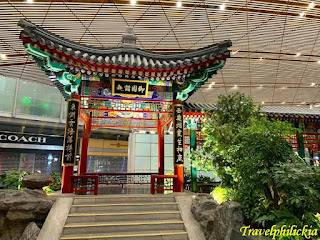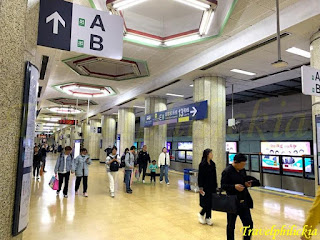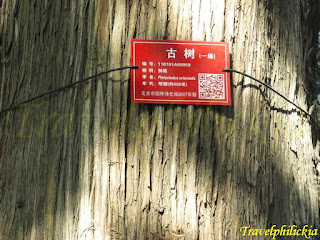My itinerary was simple; instead of visiting three to four attractions within a day like my previous trip, this time I decided to take it easy to have one major attraction during the day followed by a shopping street in the evening. However since the pandemic period, all visitors to major attractions are required to reserve in advance through mostly "mini-programs" in WeChat. These "cloud-based embedded applications within WeChat" are not user-friendly to foreigners and had interrupted my original itinerary. Fortunately, I was able to resolve them one week before the trip.
Leisure trip at a glance
Country / Region: People's Republic of China (Beijing)
Period: 14 Apr to 19 Apr 2024
Flight timings:
14 Apr: SQ 802, SIN–PEK, ETD 0830 ETA 1440
19 Apr: SQ 801, PEK–SIN, ETD 0005 ETA 0620
Air tickets:
Return tickets at SGD 549.70 (inclusive of airport taxes)
Accommodation:
Holiday Inn Express Beijing Dongzhimen – 北京东直门智选假日酒店 (14 to 18 Apr)
Currency exchange rate:
CNY 100 = SGD 19.35 (Apr '24 period)
 There is no time difference between Singapore and China as both countries are in GMT+8 time zone. Total damage was about SGD 1,200 including transport, food & hotel, and excluding personal expenses.
There is no time difference between Singapore and China as both countries are in GMT+8 time zone. Total damage was about SGD 1,200 including transport, food & hotel, and excluding personal expenses.Here's the overview of the trip itinerary:
Day 1 – Breakfast in Changi Airport then boarded flight SQ 802. Took Airport Express and checked in to Holiday Inn Express hotel. Visited Ming City Wall Ruins Park and window-shopped in Soshow Mall.
Day 2 – Visited Universal Studios and Universal Citywalk. Shopped in Beijing Book Building.
Day 3 – Explored Summer Palace and visited Drum Tower. Shopped along Nan Lou Gu street and Wangfujing street.
Day 4 – Visited Beijing Palace Museum. Back to hotel.
Day 5 – Checked out Holiday Inn Express hotel. Explored National Museum and window shopped along Qianmen street. Stopped over at a local "fresh market" before going back to hotel. Got a DiDi car to airport.
Day 6 – Took midnight flight SQ 801 back to Singapore.
Beijing Capital International Airport (北京首都国际机场)
The Beijing Capital International Airport is one of the two international airports serving Beijing, and the other airport is the Beijing Daxing International Airport. The Capital Airport is located 32-km northeast of the city center. The IATA code for this airport is PEK, which is based on the city's formal romanized name "Peking".
Terminal 3
- The Singapore Airlines uses Terminal 3 of the airport. Opened in Feb 2008, the terminal building has a roomy departure hall of spacious and bright atmosphere (photos below).


- Indoor gardens with the theme of northern Chinese gardens are constructed inside the transit area for passengers to explore (photos below). This garden feature was already there when I visited in 2009.


- Due to my renewed passport, I had to get my fingerprints recollected at the machines in this airport upon arrival (left photo below). Thereafter it took me about an hour before being cleared from the immigration checks due to overwhelming number of visitors and limited counters during that time.
This airport is so huge that after the immigration clearance, all visitors had to take the shuttle train from the one end of the terminal to the central area to collect the luggage (right photo below). Likewise during departure, I had to take the shuttle train after customs check to the end of the terminal for immigration clearance.


Transportation
Getting in/out of the Airport
- Airport Buses
There are 18 bus routes to and from points throughout the city including Xidan, Beijing railway station, Beijing South railway station, Beijing West railway station, Zhongguancun, Fangzhuang and Shangdi stops. - Airport Taxi
Taxi is convenient and fast, but also the most expensive way to get to or leave Beijing Capital Airport. - Airport Express
Airport Express runs from Terminal 3 to Terminal 2, and then to city with stops at Sanyuanqiao and Dongzhimen before ending at Beixinqiao station. It takes about 30 to 40-mins from airport to the city.
This was the transport mode I took as the Dongzhimen station is just 15-mins walk away from my hotel.
Capital Airport Express (首都机场线)
The Capital Airport Express is a dedicated airport rail link from Beixinqiao subway station to the Beijing Capital International Airport. Operating since Jul 2008, the airport express is part of the Beijing Subway system and its color code on the subway map is "purplish grey".
It is easy to locate the airport express by following the sign that reads "Subway" (地铁). The airport express has its own train station inside the Terminal 3 Transportation Hub (left photo below). Passengers can scan the Alipay "Beijing Metro Code" or buy a physical ticket from the ticketing machine to enter. Cost per trip was CNY 25 which was the same price I paid 15 years ago. Moreover, the train cabin was much modern now with bigger display screens and colorful seats compared to the one I took back in 2009 (right photo below).

 Following is the video taken when the airport express train was entering the station (video clip below).
Following is the video taken when the airport express train was entering the station (video clip below).Beijing Subway (北京地铁)
The Beijing Subway is a rapid transit system of Beijing Municipality that consists of 27 lines including 22 rapid transit lines, two airport rail links, one maglev line and two light rail tram lines, and 490 stations (photo below). Operating since Jan 1971, Beijing Subway system is the world's longest metro system by route length of 836-meters surpassing the Shanghai Metro.
- The fare used to be only CNY 2 per ride regardless of distance, but since Dec 2014 any single-ride fare is charged according to trip distance for all lines except the two airport express lines. Fares start at CNY 3 for a trip up to 6 km in distance, with additional CNY 1 added for the next 6 km, 10 km or 20 km accordingly.
Fare Payment
- Single-ride ticket in the form of an RFID-enabled plastic card can be purchased from the ticket machines located in the subway stations.
The most popular form of payment is by the Alipay "Beijing Metro Code" (left photo below). Just show the code to the reader marked with a yellow rectangular casing at the gantry (right photo below) and entrance will be granted. Almost in real time, the transaction will be shown in the Alipay application. To exit, just show the code again to the reader at the gantry.


| ✍ Update: |
|---|
| Starting from 13 Sep 2024, foreign visitors can use Mastercard and Visa cards issued overseas for 'Tap to Ride' payments at all urban rail transit stations in Beijing. |
Train Station
- Stations of older lines such as Line 2 and Line 1 (those opened in 1971) do have the interior furnishings of "Bomb-Shelters" (left photo below). However newer lines will have a modern look including its underpasses (right photo below).

 Transfer between different lines can be a hassle; where one can expect to walk 2 to 5-mins and through tunnels or stairs to different level when transferring. If carrying a heavy luggage, then do prepare to carry it up or down the stairs in stations of older lines because there is no escalator or lift available.
Transfer between different lines can be a hassle; where one can expect to walk 2 to 5-mins and through tunnels or stairs to different level when transferring. If carrying a heavy luggage, then do prepare to carry it up or down the stairs in stations of older lines because there is no escalator or lift available.Train Cabin
- Subway train cabin is clean and spacious where announcements are made in Mandarin and English (photos below).


- All hand-carry bags or luggage from passengers entering any subway station will have to be scanned. The scanning machines used are similar to those used in the airports. Some of these machines even have two levels where the larger luggage can be placed on lower level and hand-carry bags on upper level.
Do expect to wait a little longer in the queue before boarding the subway during peak hours.
Misleading Information
- Station lookup using the popular search engine "Gxxxle" tends to give incorrect status that a particular station is "Permanently closed" (photos below). Similarly all the Chinese metro stations are no longer showed on "Gxxxle" maps. In fact, these metro or subway stations are still in operation. To date, there is no confirmed explanation behind this misleading information.


DiDi Ride (滴滴出行)
Besides Airport Express and subway trains, I also hired a DiDi car to fetch me from the hotel to the airport.
Holiday Inn Express Beijing Dongzhimen (北京东直门智选假日酒店)
The Holiday Inn Express Beijing Dongzhimen is a 4-star hotel located within 10-mins walk from "Workers' Stadium" station (工人体育场站) of Line 3 and 17 or 15-mins walk from "Dongzhimen" station (东直门站) of Line 2 and 13 (left photo below). Booked this hotel online at CNY 3,007.73 for four nights per standard room with daily breakfast. The hotel do provides complimentary beverages to all guests at its lobby (right photo below).


The room design was simple with functional furnitures such as the working desk (left photo below) and the couch with a side table for me to have my supper comfortably (right photo below).

 The hotel offered a variety of Western and Chinese style breakfast buffet in its restaurant located on the second floor (photos below). It even has a corner with chiefs to serve soup noodles upon request by guests.
The hotel offered a variety of Western and Chinese style breakfast buffet in its restaurant located on the second floor (photos below). It even has a corner with chiefs to serve soup noodles upon request by guests.



Following were the buffet selections on my second day of stay (photos below).

 Similar choices were made on my third day of stay (photos below).
Similar choices were made on my third day of stay (photos below).

 Breakfast selections were almost the same throughout on the fourth day (photos below).
Breakfast selections were almost the same throughout on the fourth day (photos below).

Likewise, choices were typical on my fifth (last) day of stay (left photo below). Finally, I got to try the Henan-style mutton "Hui Mian" (绘面) or braised noodles served from the noodle corner. Perhaps due to its style of cooking or the mutton, I did not appreciate this soup noodle well.

 Interesting Observations
Interesting Observations- Recycling program is definitely more successful in Beijing than Singapore; where trash is classified into four categories in Beijing (left photo below) compared to all types of recyclable materials thrown into a single recycling bin in Singapore. In addition, since beginning of 2023 all single-use plastic bags are banned in China, with the exception of markets selling fresh produce until 2025. I guess Singapore may have a long way to go on these efforts.
- Windshield quilt just left by their owners on the electronic bikes parked beside the main road (right photo below). Temperature can be low as 15 °C in the morning during my visit and the windshield quilt definitely helps to protect the riders from the bitter winds.
- Besides the cultural relics in the museums, there are also living treasures found in parks and gardens. Do look out for small tags with simple information hanging on the trees:• Red Tag indicating first tier tree that are about 400 years old since Ming Dynasty (left photo below)• Green Tag indicating second tier tree that are about 200 years old since Qing Dynasty (right photo below).
- From the cosplay costumes wore by most visitors in the Universal Studios, they are more enthusiastic and die-hard fans of Harry Potter than the Japanese (photos below). I even saw several families where both parents and their young children dressed up in Harry Potter robes and scarfs.
- Children as well as the young and "not-so-young" adults gowned up in traditional costumes when visiting the forbidden city (photos below). The six centuries old palace museum seems to have transformed into a theme park just like the Universal Studios.
- Spotted a typical Beijing Hutong Doorway in my previous trip and did a write-up on the definition of "门当户对" in the blog here.
"Mendang" (门当) or stone piers are placed on both sides of the entrance door, and were used as decorations and to stabilize the facade. In this trip, I saw two doorways with a totally different design; one has a pair of stone piers in the shape of a box (left photo below) while the other has a pair of round stone piers (right photo below). The box-shaped stone piers were supposed to represent the residence of a literary official while the round or drum-shaped stone piers represented the residence of a military officer.

- A new way to explore Beijing is to collect the associated ink stamps from its various attractions (photos below). Common in Japan, this new trend has started to be popular among the younger generations. These ink stamps can be found in most tourist attractions and even in some souvenir shops or malls. However do note that not all shops offer free stamps, and some even required customers to spend certain amount before able to use their ink stamps.

- The traditional 'Honey flavored yogurt' (蜂蜜酸牛奶) by producer 'sheng xiang' (圣祥) had a new look with a contemporary looking white bottle and marketed as "老北京酸奶" (left photo below). However the cost had increased from just CNY 4 back in 2009 to the current CNY 15 sold in Wangfujing shopping street. Nevertheless its taste was still as good as the one I had 15 years ago.
- Speaking of food, saw this interesting "Parsley Instant Noodles" in a supermarket (right photo below). Bought a pack of five individual sachets at CNY 28.80 to try. Taste was not that special as it was just the usual spicy beef broth flavor with two extra packs of dried Chinese parsley.
Some useful links:
- National Geographic - Beijing Travel Guide:
https://www.nationalgeographic.com/travel/destination/beijing
- Traveling in Beijing:
https://english.beijing.gov.cn/travellinginbeijing/
- Beijing - Wikivoyage:
https://en.wikivoyage.org/wiki/Beijing
- Beijing - Wikitravel:
https://wikitravel.org/en/Beijing
 Posts RSS
Posts RSS

















